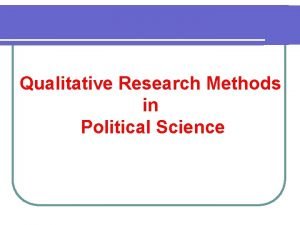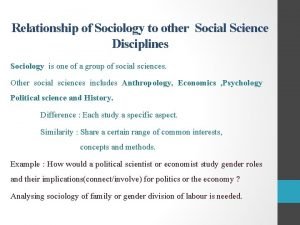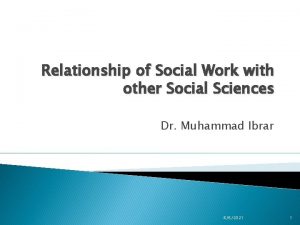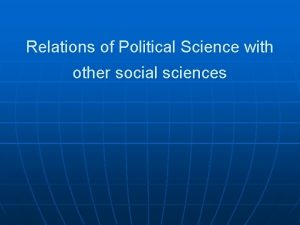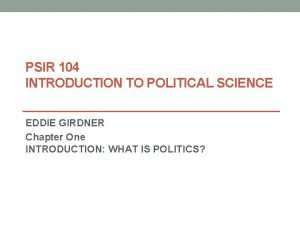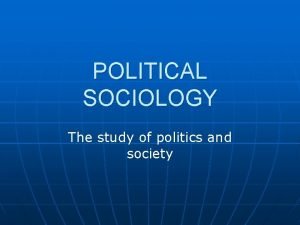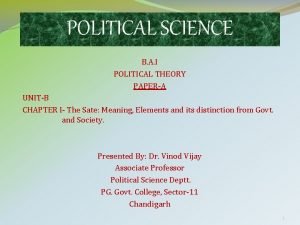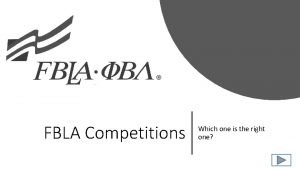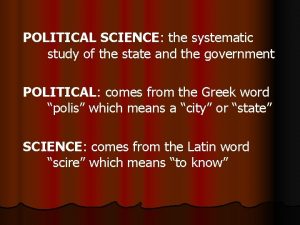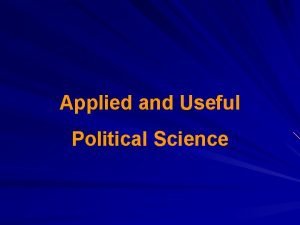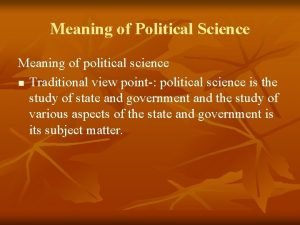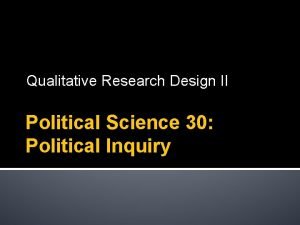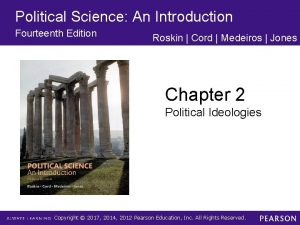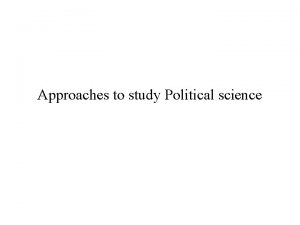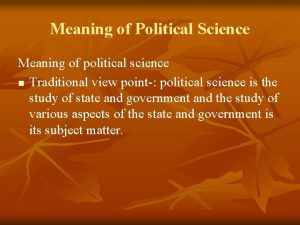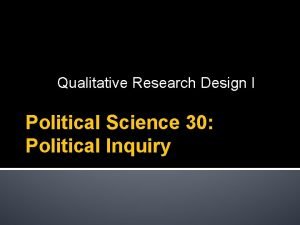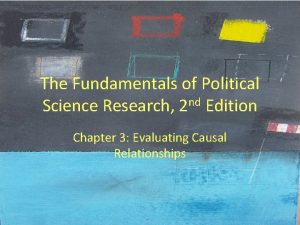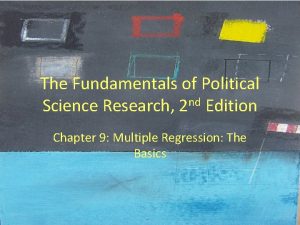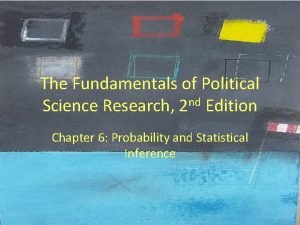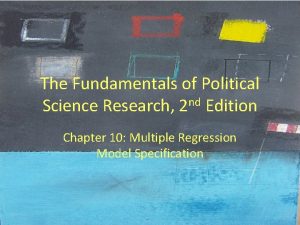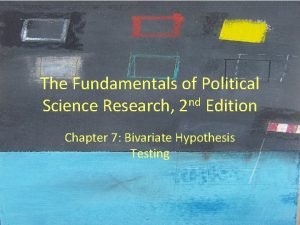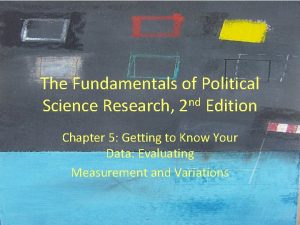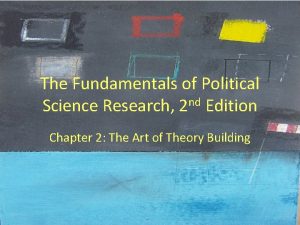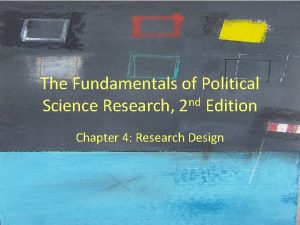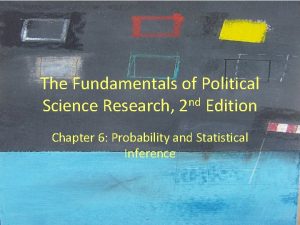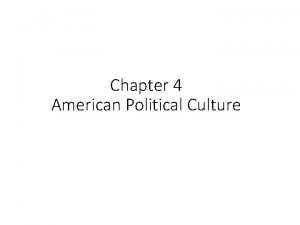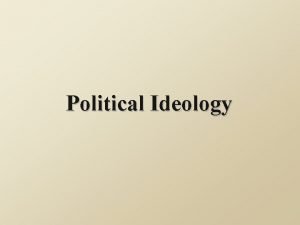The Fundamentals of Political Science Research 2 nd






















- Slides: 22

The Fundamentals of Political Science Research, 2 nd Edition Chapter 4: Research Design

Chapter 4 Outline • Comparison as the key to establishing causal relationships • Experimental research designs • Observational studies (in two flavors)

What is being compared to what? • Recall from our discussions of the examples in Chapter 3 that making good comparisons is one of the keys of doing social science. • The simple bivariate comparison of participants in a Head Start program to those who are not in the program, despite its initial appeals, can be very misleading. (Why? ) • If the comparisons we make are faulty, then our conclusions about whether or not a causal relationship is present are also likely to be faulty. (But we're never sure one way or the other. ) • What to do?

Research design • So let's say that we have a theory that says that some X causes some Y. • We don't know whether, in reality, X causes Y. We may be armed with a theory that suggests that X does, indeed, cause Y , but theories can be (and often are) wrong or incomplete. • So how do scientists generally, and political scientists in particular, go about testing whether X causes Y ? There are several strategies, or research designs that researchers can employ toward that end. • The goal of all types of research designs are to help us evaluate how well a theory fares as it makes its way over the four causal hurdles-that is, to answer as conclusively as is possible the question about whether X causes Y.

Two approaches • We will talk about two broad approaches to designing research. The first is called an experimental design, and it is the benchmark of scientific research. The second is meant to emulate the first, and is called an observational study. • We'll take them in turn.

An example from day-to-day political life • Suppose that you were a candidate for political office locked in what seems to be a tight race. You're deciding whether or not to make some television ad buys for a spot that sharply contrast your record with your opponent's. • The campaign manager has had a public-relations firm craft the spot, and has shown it to you in your strategy meetings. You like it, but you look to your staff and ask the bottom-line question: “Will the ad work with the voters? ”

Can you see the causal question? • Exposure to a candidate's negative ad (X) may, or may not, affect a voter's likelihood of voting for that candidate (Y ). • And it is important to add here that the causal claim has a particular directional component to it; that is, exposure to the advertisement will increase the chances that a voter will choose that candidate. • How might researchers in the social sciences evaluate such a causal claim?

Think about the comparison • How can we most effectively make a comparison to answer our causal question? • It is very important, and not at all surprising, to realize that voters may vote for or against you for a variety of reasons (Zs) that have nothing to do with exposure to the ad--varying socioeconomic statuses, varying ideologies, and party identifications can all cause voters to favor one candidate over another. • So how can we establish whether or not, among these other influences (Z), the advertisement (X) also causes voters to be more likely to vote for you (Y )?

The possibly confounding effects of political interest in the advertisement-vote intention relationship

An experiment • The word “experiment” has many uses in the English language, but in this class we'll use it in a rather precise (picky? ) way. • An experiment is a research design in which the researcher both controls and randomly assigns values of the independent variable to the subjects. • These two components--control and random assignment--form a necessary and sufficient definition of an experiment.

Control • What does it mean to say that a researcher “controls” the value of the independent variable that the subjects receive? • It means, most importantly, that the values of the independent variable that the subjects receive are not determined either by the subjects themselves, or by nature. • In our campaign-advertising example, this requirement means that we cannot compare people who, by their own choice, already view the ad to those who do not (in this case the choice of whether or not to view the ad is a Z variable that may exert an influence on Y separate from X). • It means that we, the researchers, have to decide which of our experimental subjects will view the and which ones will not.

Random assignment • We, the researchers, not only must control the values of the independent variable, but we must also assign those values to subjects randomly. • In the context of our campaign-ad example, this means that we must toss coins, draw numbers out of a hat, use a random-number generator, or some other such mechanism to ensure that our subjects are divided into a treatment group (who will view the ad) and a control group (who will not view it, but will instead presumably watch something innocuous).

Experiments and internal validity • How do experiments help us cross the four hurdles? Take them one at a time. – – 1 Is there a credible causal mechanism that connects X to Y ? 2 Can we rule out the possibility that Y could cause X? 3 Is there covariation between X and Y ? 4 Have we controlled for all confounding variables Z that might make the association between X and Y spurious? • Because experiments deal with the fourth hurdle so effectively, they are said to have high degrees of internal validity -- that is, the inferences we make about whether X causes Y or not are likely to be correct.

Drawbacks to experiments • 1 Can we really assign X to subjects? • 2 What about external validity? – Samples of convenience and replication – External validity of the stimulus • 3 Are there ethical considerations? • 4 The mistake of emphasis

If not an experiment, then what? • If we cannot evaluate causal theories in a controlled setting like an experiment, we have to take the world as it already is, and use what are called observational studies. • Definition: An observational study is a research design in which the researcher does not have control over values of the independent variable, which occur naturally. However, it is necessary that there be some degree of variability on the independent variable between cases, as well as variation in the dependent variable. • Some maintain that, in the absence of experiments, we cannot demonstrate causality with any degree of confidence, but only correlation. We disagree.

Observational studies and the four causal hurdles • How do the four causal hurdles change? Not at all. • Hurdles 1 and 3 are rather similar between experiments and observational studies. • Hurdles 2 and 4 are a bit different, though. How so?

Two types of data, two types of observational studies • What is the unit of observation? (individuals vs. aggregates) • Two types of data sets • Two types of observational studies, focusing on two different types of variation

Variation through space at one point in time

Variation through time in one spatial unit

Cross-sectional observational studies • A cross-sectional observational study examines a crosssection of social reality, focusing on variation between individual spatial units -- again, like citizens, elected officials, voting districts, or countries--and explaining the variation in the dependent variable across them. • Example: What, if anything, is the connection between the preferences of the voters from a district (X) and a representative's voting behavior (Y )? • We could compare the aggregated preferences of voters from a variety of districts (X) to the voting records of the representatives (Y ). • This particular X is not at all subject to experimental manipulation.

Time-series observational studies • In the time-series observational study, political scientists typically examine the variation within one spatial unit over time. • For example, how, if at all, do changes in media coverage about the economy (X) affect public concern about the economy (Y )? That is, when the media spend more time talking about the potential problem of inflation, does the public show more concern about inflation; and when the media spend less time on the subject of inflation, does public concern about inflation wane? • We need to focus hard on that fourth causal hurdle. Are there any other variables (Z) that are related to the varying volume of news coverage about inflation (X) and public concern about inflation (Y )?

How many variables do I need to control for? • All of them, or substantial problems arise. • How is this done? By the use of statistical controls.
 The fundamentals of political science research 2nd edition
The fundamentals of political science research 2nd edition Qualitative research methods in political science
Qualitative research methods in political science Eric’s favourite .......... is science. *
Eric’s favourite .......... is science. * Chapter 6 fingerprints
Chapter 6 fingerprints Esp trend lab
Esp trend lab Umass lowell political science
Umass lowell political science Csusm political science
Csusm political science Sociology social science
Sociology social science Relation of social work with other social sciences
Relation of social work with other social sciences Relation between political science and sociology
Relation between political science and sociology Branches of political science
Branches of political science Sociology vs political science
Sociology vs political science Relation between political science and psychology
Relation between political science and psychology How do fbla competitions work
How do fbla competitions work Warsaw university political science
Warsaw university political science Systematic study of state and government
Systematic study of state and government Relationship between political science and geography
Relationship between political science and geography What is the official publication of fbla?
What is the official publication of fbla? Limitations of political science
Limitations of political science Conclusion of political science
Conclusion of political science Ecupl
Ecupl Qualitative vs quantitative political science
Qualitative vs quantitative political science Political science 14th edition
Political science 14th edition

